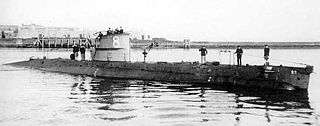
HMS H6 was a British H-class submarine of the Royal Navy built by Canadian Vickers & Co. during World War I.
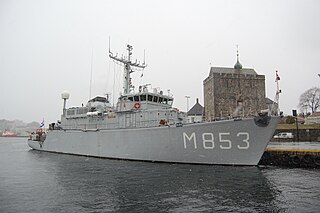
The Alkmaar class is a ship class of fifteen minehunters that were built in the Netherlands for the Royal Netherlands Navy. They are based on the design of the Tripartite class, which was developed by a collaborative effort between the Netherlands, Belgium and France, and replaced the minesweepers and minehunters of the Dokkum class.

HNLMS Poolster was a replenishment ship serving with the Royal Netherlands Navy. Poolster entered service on 29 June 1964. In 1994 she was decommissioned and sold to the Pakistan Navy where the ship was renamed Moawin. A later replenishment ship Zuiderkruis was based on Poolster. In the Dutch navy she was replaced by the replenishment ship Amsterdam. She was the first ship in the Dutch navy with inbuilt protection against radioactive fallout.

HNLMS Zeeland (D809) was a destroyer of the Holland class. The ship was in service with the Royal Netherlands Navy from 1955 to 1979. The destroyer was named after the Dutch province of Zeeland and was the twenty-first ship with this name. In 1978 the ship was taken out of service and later broken up and scrapped. The ship's radio call sign was "PAAU".

HNLMS Gelderland (D811) was a destroyer of the Holland class. The ship was in service with the Royal Netherlands Navy from 1955 to 1973. The destroyer was named after the Dutch province of Gelderland and was the twenty-first ship with this name. In 1973 the ship was taken out of service, after which it was given a berth in Amsterdam for the Technical Training Royal Navy (TOKM) school. During her service the ship's radio call sign was "PARY". The ship was sold for scrapping in 1988.
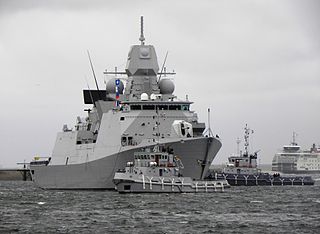
The Linge class are a series of tugboats used by the Royal Netherlands Navy to dock their larger ships at the Nieuwe Haven Naval Base.

The Breezand class are a class of tugboats used by the Royal Netherlands Navy, primarily to dock their smaller ships at the Nieuwe Haven Naval Base. In winter they are also used as icebreakers.

The Balder-class patrol vessels were a class of five patrol vessels built for the Royal Netherlands Navy in the 1950s at the Rijkswerf in Willemsoord, Den Helder. They were paid for by the United States under the Mutual Defense Assistance Program (MDAP). The ships were used to patrol the Dutch coast and waterways.
HNLMS Wamandai (A870) was a tugboat of the Royal Netherlands Navy (RNN). She was built in the Netherlands and served between 1962 and 1985 in the RNN.
HNLMS Thetis (A887) was a accommodation ship of the Royal Netherlands Navy. It was used as a diving and disassembly school.
HNLMS Wambrau (A871) was a tugboat of the Royal Netherlands Navy (RNN). She served in the RNN between 1957 and 1987.
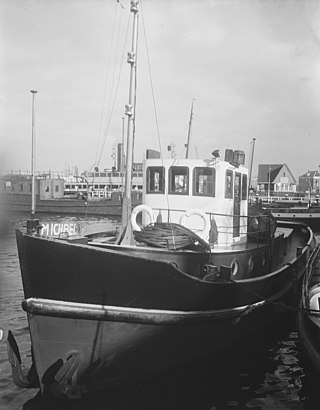
HNLMS Orkaan (A837) was a tugboat of the Royal Netherlands Navy (RNN). She served in the RNN between 1949 and 1961. It was at the time the largest tugboat to be built in the Netherlands for the RNN.

HNLMS Johan Maurits van Nassau (F802) was a River-class frigate of the Royal Netherlands Navy (RNN). She was built in the United Kingdom originally for the Royal Navy as HMS Ribble, however, during the construction the frigate was acquired by the RNN. She served in the RNN between 1943 and 1958.

HNLMS Zeefakkel was a hydrographic survey vessel built in the Netherlands for the Royal Netherlands Navy. She was specially designed to perform surveys in coastal areas and did this between 1951 and 1972. Later she was turned into a training vessel.

HNLMS Jan van Brakel was a minelayer and patrol vessel of the Royal Netherlands Navy (RNN). She was built in the Netherlands and served in the RNN between 1936 and 1957.

HNLMS Van Bochove (A923) was a ship of the Royal Netherlands Navy that was used to test torpedoes. After the removal of its torpedo tubes the ship served for a while as a communication ship.

The Westgat class was a ship class of two tugboats that were built in the Netherlands for the Royal Netherlands Navy. One of the vessels was later sold to the Belgian Navy.
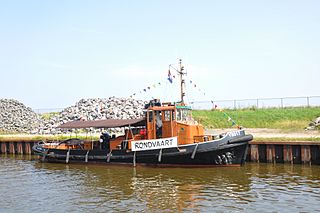
The Bambi class was a ship class of two tugboats that were built in the Netherlands for the Royal Netherlands Navy.
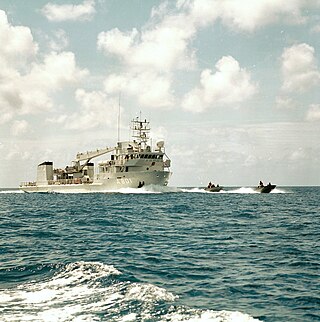
HNLMS Pelikaan (A801) was a logistic support vessel of the Royal Netherlands Navy.
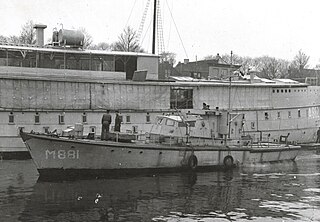
The Keeten class was a ship class of three minesweepers that served in the Royal Netherlands Navy (RNN) between 1946 and 1964. They were former Royal Navy harbour defence motor launches sold to the RNN in 1946.

















